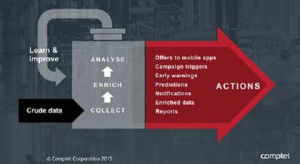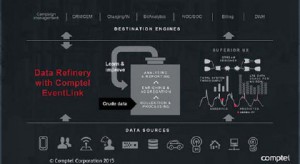Whether you’re a car manufacturer, a utility company or a communications service provider (CSP), one thing is for sure: the amount of structured and unstructured data generated in your operations is only going to continue to rise dramatically. That data represents a great opportunity, writes Mikko Jarva
Cisco estimates that mobile data traffic will grow at a compound annual growth rate (CAGR) of 61% from 2013 to 2018, reaching15.9 exabytes per month. A significant contributor to this traffic growth is the Internet of Things (IoT); forecasts say that there will be 50 billion connected devices by 2020.
The growing amount of data and its inherent insights presents an opportunity, but right now a lot of that information is not being utilised to its full potential. Research from TeleTech shows that 95% of CSP businesses collect and store multi-dimensional customer information, but only 60% are able to
transform it into usable form. In addition, while 30% are able to regularly identify value generation
opportunities from it, only 20% are able to turn the opportunities into action. If data isn’t integrated, analysed and acted upon across all sources, companies will never be able to unlock the true potential of their customers or operations. Instead of analysing and acting on old big data, businesses need to start thinking about how to utilise streaming information in the moment, enabling them to quickly determine the immediate actions they should take and maximise their opportunities. For example, someone who is about to hit a bandwidth cap while watching a movie will be more willing to top up their data quota at that exact time rather than three days later. CSPs need to make sure they don’t miss out on that potential revenue.
To fully monetise data, organisations need to be able to have unfiltered access to it and be able to refine and analyse it in real-time. As customers’ digital behaviours get more sophisticated, so too must the systems that process all of their transactions and interactions. Comptel’s vision of Operation Nexterday will help bring this sophistication into companies’ systems, so they align with and best serve, meet and respond to the needs of the cloud generation.
Intelligent, automated analytics
Gartner predicts that advanced, pervasive and invisible analytics will be one of the top ten technology
trends of 2015. As data floods back-end systems, in order to reduce manual work, analytics-driven
enrichment and automated decision-making will have to become the cornerstone for operations, customer experience and business growth.
Managing the expansive growth in information complexity, volume and speed requires that intelligent
machine-learning algorithms are employed and automated. Machine learning can be used to identify
patterns in data streams that can be then used for predictions or early detection of new signals – the two
most important aspects of proactive insights.
Mediation systems have already evolved beyond collecting network data for billing and should expand
to meet the needs of nexterday. A nexterday mediation platform should consist of a data processing layer that integrates information from every potential source such as customers, operations, locations, social media, apps, cars, houses and wearables, and offers in-stream contextual intelligence to drive the right actions, at the right times and through the right channels. But what will this new kind of in-stream contextual intelligence layer actually look like? And how will it work?
Data refinery: embedded intelligence
A data refinery takes the best parts from Comptel EventLink, Comptel’s big data mediation technology,
specifically its massive scalability and ability to integrate, aggregate and correlate virtually any data sources, and adds in machine learning, which enables in-stream pattern matching, anomaly detection and predictions. Machine learning is an iterative process, so the more data that is used for learning means that over time the better the results, such as predictions, become. A data refinery establishes an intelligent data mediation layer that can collect and analyse all data across all platforms, from mobile devices to networks and cars, and delivers insights and actions to appropriate destinations such as mobile applications, customer relationship management systems, network operations and campaign management systems.
Examples of such insights and actions include:
• A recommendation for a Netflix-tailored data package sent to a mobile application, when the customer is about to run out of data quota while watching a movie
• Upsell campaign triggers sent to a campaign management system based on customer affinity
• Early warnings on abnormally high cell utilisation levels sent to radio network operations
• A list of network elements most likely to have issues in the next 24 hours sent to network management systems
• A notification sent to fleet management systems when a connected car drives to an unexpected area
With such a multitude of potential uses, use cases and users, it’s very easy for things to get complicated.
Fortunately, a data refinery provides a modern, intuitive and clean user experience, which allows users to keep it simple, while building easily configurable workflows fast around different use cases. In the back end, a data refinery provides rich reporting capabilities on the integrated data streams, which enables the evaluation of the success of the deployed use cases as well as delivers insights for designing new ones.
With so much data coming through every business, it’s critical for companies to have an intelligent data
processing layer that can ensure no valuable information goes to waste. They must harness raw, real-time data across every possible source and turn that into business opportunities. An intelligent, automated and real-time data refinery is the logical next step – data is already everywhere, and only by
enriching that information with analytics, can businesses make sense of it all.








